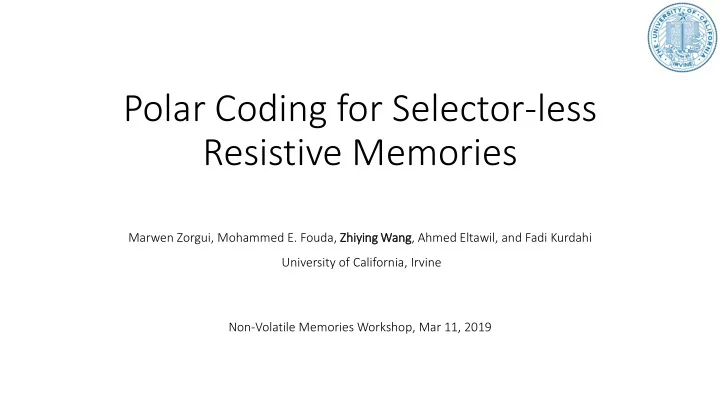

Polar Coding for Selector-less Resistive Memories Marwen Zorgui, Mohammed E. Fouda, Zhiying Wang, Ahmed Eltawil, and Fadi Kurdahi University of California, Irvine Non-Volatile Memories Workshop, Mar 11, 2019
Agenda • Varying Sneak Path in Resistive Memory • Polar Codes for Varying Channels • Application to Crossbar Arrays • Conclusion 2
Emerging Memory Technologies Parameter FeRAM STTRAM PCRAM ReRAM Maturity Product Product Product Product Feature Size F>45nm 10n<F<45n F< 10 nm F< 10 nm 3D Integration Difficult Possible Feasible Feasible < 10 10 > 10 10 < 10 5 > 10 10 Endurance Retention <10 years <10 years <10 years >10 years Latency <100ns <100ns <100ns ≤ 5𝑜𝑡 Power Low Medium Medium Low Variability low Reasonable Reasonable Reasonable D. C. Daly and et al., “Through the looking glass– the 2017 edition: Trends in solid-state circuits from isscc ,” IEEE Solid -State Circuits Magazine, 2017 3 S. Yu, P.Chen :” Emerging Memory Technologies” IEEE SOLID -STATE CIRCUITS MAGAZINE, 2016
Crossbar One-Step Reading 4 Fouda , et al. “On Resistive Memories: One Step Row Readout Technique and Sensing Circuitry”, arXiv:1903.01512
Sneak Path Feature size F Wire resistance 𝑆 𝑥 5Ω 50nm 5nm 90Ω 5 Fouda , et al. “On Resistive Memories: One Step Row Readout Technique and Sensing Circuitry”, arXiv:1903.01512
Varying Sneak Path 𝑆 𝑥 = 30Ω 1 st bitline 16 th bitline 32 nd bitline 6
Varying Channels • Threshold per cell, per row, per column, or Encoder per array • Training: Logistic regression-based • => Binary symmetric channels (BSCs) with Address Decoder varying error probabilities Sensing Circuit 𝑾 𝒖𝒊 Decoder 7
Polar Coding • Low complexity encoding and decoding: O(N log N) • Provably capacity-achieving • Adaptable to different scenarios, including varying channels 8
Basic Polar Transformation & Properties Channel combination Channel splitting Capacity conservation & Extremization Arikan, Erdal . “Channel polarization: A method for constructing capacity -achieving codes for symmetric binary- input memoryless channels”, IEE E Trans. Inf. Theory. 2009 9
Recursive Application of Polar Transformation Size 8 polar code construction Size 4 polar code construction 𝑌 0 𝑍 𝑉 0 0 0 𝑌 0 𝑍 𝑌 1 0 𝑉 1 𝑍 𝑉 0 1 0 1 𝑌 2 𝑉 2 𝑍 2 𝑌 1 𝑍 2 1 𝑌 3 𝑉 1 1 𝑉 3 𝑍 3 3 𝑌 4 𝑍 𝑌 2 𝑍 𝑉 4 4 2 4 𝑉 2 2 𝑌 5 𝑉 5 𝑍 5 5 𝑌 3 𝑍 𝑌 6 3 𝑍 𝑉 6 𝑉 3 3 6 6 𝑌 7 𝑉 7 𝑍 7 7 10
Systematic Polar Codes for Varying Channels • We have N channels of different reliabilities • Polarization theory extends to this setup [1] • Fraction of good polarized channels approaches the average of the channels’ capacities [2] • Moreover, systematic codes have better empirical bit error rate (BER) [3] • Question: Can we reorder the channels to get better BER? [1] Alsan, Mine and Telatar , Emre. “A simple proof of polarization and polarization for non - stationary memoryless channels”, IEEE Trans. Inf. Theory. 2016 [2] Mahdavifar, Hessam . “Fast polarization for non - stationary channels”, IEEE ISIT. 2017 [3] Arikan, Erdal. "Systematic polar coding." IEEE comm. letters, 2011. 11
Proposed Ordering of the Channels • Assume the channels are such that 𝐽 𝑋 0 ≤ 𝐽 𝑋 1 ≤ ⋯ ≤ 𝐽 𝑋 𝑂−1 • We propose the use of the bit-reversal permutation Ψ • Example: 𝑂 = 8; Ψ = (0 , 4, 2, 6, 1, 5, 3, 7) 𝑦 0 𝑦 4 𝑦 2 𝑦 6 Ψ 𝑦 1 𝑦 5 𝑦 3 𝑦 7 • Bit-reversal permutation has been proposed in the context of rate-compatible polar codes [1] 12 [1] Niu , Kai et.al. “Beyond turbo codes: Rate - compatible punctured polar codes”, IEEE ICC. 2013
Example for Synthetic Channels • Binary symmetric channels (BSCs). • Raw BER (p) are linearly spaced with maximum deviation of 0.045. • Bit-reversal permutation performs empirically good. • Systematic encoding gain. Rate = 0.5, N=1024 13
Application to the Crossbar Array • Transform the read cells into BSC’s: • Estimate a threshold for each row (wordline) by logistic regression • Estimate the raw BER for each cell • Apply proposed polar codes with the estimated raw BER • Encode each row separately 14
Coding per Wordline 32 × 32 array , 𝑆 = 0.5, 𝑆 𝑥 = 30Ω, 𝑀𝑆𝑇 = 1𝐿Ω, HRS = 1MΩ 15
Conclusion and Future Work ➢ Applied polar codes to the sneak path problem in resistive arrays ➢ Proposed channel ordering method to improve the performance ➢ Enhanced performance compared to regular polar codes ➢ Future directions: ❖ Modeling and soft-information decoding ❖ Encoding the entire array for storage systems ❖ Enhanced successive-cancellation list decoding 16
Recommend
More recommend